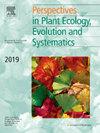Using plant functional traits and life strategies of annual species to inform green roof plant selection
IF 2.9
3区 环境科学与生态学
Q1 ECOLOGY
Perspectives in Plant Ecology Evolution and Systematics
Pub Date : 2025-09-17
DOI:10.1016/j.ppees.2025.125900
引用次数: 0
Abstract
Functional traits of plant species growing on green roofs can determine their delivery of ecosystem services and help guide plant selection. Flowering plants are desirable on green roofs for aesthetic reasons and plants which quickly achieve high coverage through rapid growth and high biomass help to meet green roof construction guidelines. While most extensive green roof plants are perennial succulents due to their drought tolerance, annual species which escape drought by completing their life-cycle before drought, could be advantageous for green roofs as they also typically have acquisitive or ‘fast’ traits associated with rapid growth and flowering. To quantify plant strategies of annuals and develop a trait-based approach for selecting annuals for green roofs, we undertook a glasshouse experiment with 18 understudied Australian annual plant species to investigate relationships among traits related to drought resistance and resource acquisition (specific leaf area, leaf dry matter content and leaf thickness), competitiveness (plant height) and reproductive ability (seed mass and germination attributes). We also explored how these traits relate to plant performance metrics including growth rate, shoot biomass and flowering time. Species which were more acquisitive (taller species with bigger and thinner leaves and greater seed mass) were more competitive, faster growing and produced more biomass. The annual species had two different strategies in terms of flowering time and relative growth rate; in one group flowering time decreased with an increase in growth rate (earlier flowering with faster growth), while in the other group, flowering time increased with growth rate (later flowering with faster growth). There was also a trade-off between flowering time and specific leaf area (SLA) and faster flowering species with higher SLA were considered less drought resistant (drought escapers). Faster growing and resource acquisitive plants could be more desirable on green roofs as they will achieve cover rapidly during the wetter months and have higher stormwater mitigation. However, in dry periods it is preferable to select species with a range of time to flowering and SLA, to achieve a longer flowering community with different levels of drought resistance.
利用一年生植物的功能性状和生命策略为屋顶绿化植物选择提供依据
植物在屋顶绿化上生长的功能性状可以决定其生态系统服务的提供,并有助于指导植物的选择。由于美观的原因,开花植物在绿色屋顶上是可取的,通过快速生长和高生物量迅速实现高覆盖的植物有助于满足绿色屋顶建设指南。虽然大多数绿色屋顶植物都是多年生多肉植物,因为它们具有耐旱性,一年生植物通过在干旱之前完成其生命周期来逃避干旱,可能对绿色屋顶有利,因为它们通常也具有与快速生长和开花相关的获取或“快速”特征。为了量化一年生植物的植物策略,建立基于性状的绿化屋顶选择方法,我们对18种澳大利亚一年生植物进行了温室试验,研究了抗旱性和资源获取(比叶面积、叶干物质含量和叶厚)、竞争力(株高)和繁殖能力(种子质量和发芽属性)等性状之间的关系。我们还探讨了这些性状与植物生长速率、茎部生物量和开花时间等性能指标的关系。获取性强的物种(较高的物种,叶片更大更薄,种子质量更大)更具竞争力,生长速度更快,生物量更多。一年生植物在开花时间和相对生长率上有两种不同的策略;其中一组开花时间随生长速度的增加而缩短(开花越早,生长越快),而另一组开花时间随生长速度的增加而增加(开花越晚,生长越快)。开花时间与比叶面积(SLA)之间也存在权衡关系,比叶面积(SLA)越高、开花越快的树种抗旱性越差。绿色屋顶上生长速度更快、资源获取性更强的植物可能更受欢迎,因为它们将在潮湿的月份迅速覆盖屋顶,并具有更高的雨水缓解效果。而在干旱期,最好选择有一定花期和一定的SLA的树种,以获得较长的开花群落和不同的抗旱性。
本文章由计算机程序翻译,如有差异,请以英文原文为准。
求助全文
约1分钟内获得全文
求助全文
来源期刊
CiteScore
6.50
自引率
0.00%
发文量
28
审稿时长
67 days
期刊介绍:
Perspectives in Plant Ecology, Evolution and Systematics (PPEES) publishes outstanding and thought-provoking articles of general interest to an international readership in the fields of plant ecology, evolution and systematics. Of particular interest are longer, in-depth articles that provide a broad understanding of key topics in the field. There are six issues per year.
The following types of article will be considered:
Full length reviews
Essay reviews
Longer research articles
Meta-analyses
Foundational methodological or empirical papers from large consortia or long-term ecological research sites (LTER).

 求助内容:
求助内容: 应助结果提醒方式:
应助结果提醒方式:


